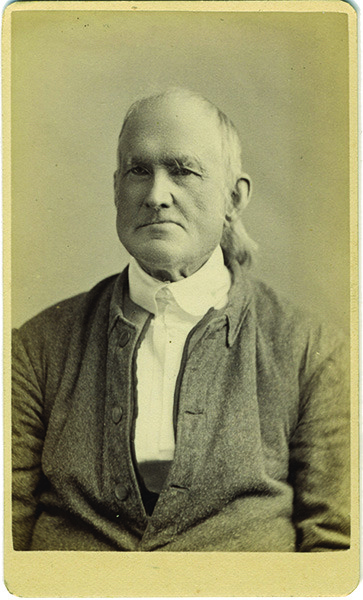
Carte de visite
W.G.C. Kimball, Photographer, Concord, NH, ca. 1880
Collection of Hancock Shaker Village, Pittsfield, MA.
Elder Orville Dyer
Orville Dyer, respected Shaker leader, was born June 15, 1804, in Stratford, New Hampshire, the son of Joseph and Mary (Marshall) Dyer.
Eight-year-old Orville Dyer, his parents, five siblings, and several family associates arrived at the Enfield Shakers in 1812. They were the first large group of converts to be accommodated at the newly formed “Gathering Order” or North Family.
Orville’s mother, Mary Marshall Dyer, left the Society in 1814. She became a lifelong opponent of the Shakers, hoping not only to recover control of her children, but also to limit, through legislation, the parental and financial rights of those who joined the Society. We do not know how much Orville was aware of the public spectacle created by his parents’ divorce and Mary’s widely publicized campaigns that included her anti-Shaker publication, A Portraiture of Shakerism (1822).
However, when Orville was 20 he along with many others contributed to A Review of Mary M. Dyer’s Publication, Entitled “A Portraiture of Shakerism,” together with Sundry Affidavits, Disproving the Truth of Her Assertions (1824). In his affidavit, he wrote:
I was brought to Enfield, N. H. by my father to with the United Society called Shakers, in the fall of the year 1812, when I was eight years old, and have lived with them going on twelve years, and they have always treated me with kindness both in sickness and health. I have been as well used as I could have been by my parents, And I do not live with them by any compulsion, but of my own free will and choice. I have always been satisfied with my home, if I had not been, I could have petitioned to my father for another, who has always been very kind to me, and that is as much liberty as I want.
I have lately seen in the New-Hampshire Statesman, of May 3d, 1824, a phrase inserted by my mother, pleading for a law, and to obtain her children. She need not put herself to that trouble about us, as there is no law to compel me to live with the Shakers, contrary to my choice. I do not wish to have one made to compel me away from the Shakers…. I think I am old enough to choose for myself, without being compelled by a law, as I am in the twentieth year of my age, and am six feet and two inches and a half in height. (pp. 58-59)
Orville’s physical stature was frequently noted by others. At the time when Orville was serving as an associate elder, former Enfield brother Hervey Elkins, in his book, Fifteen Years in the Senior Order of Shakers (1853), described him as:
A man of lofty stature–six feet, three inches in height, straight, well proportioned, weighing about two hundred and ten pounds, ambitious, always foremost in manual labor and not elevated in education above the middle stratum,–he excelled in aptitude for leading and inspiring other, if not in judgment, all the other men of the bishoprick [sic]. He supervised the construction of their most splendid edifice…with an architectural taste which has introduced to the interior a combination of space, beauty, symmetry and the light and splendor of a summer’s day.
Orville’s ability to lead and inspire others was recognized by New Hampshire’s ministry. In 1831 he was appointed associate to Elder John Beck. In 1844 when his mentor died, Orville became First Elder of the Church at Enfield. He served in that position until 1863. When Trustee Caleb Dyer was murdered Orville took over as Trustee. It was hoped that he would be able to reconstruct his brother’s business dealings from the inadequate and scattered records Caleb left behind. He was not successful in this herculean task, but remained First Trustee for several years.
From 1863 almost until his death in 1882, Orville served either as First Elder of the Church or First Trustee. Whatever his leadership position, he was loved and respected by his Shaker family. In 1896 they honored his noble Shaker life by placing his portrait in the middle hall of the Great Stone Dwelling, “in memory of his consecrated labor in its construction.”
Orville Dyer died June 16, 1882, at the Shaker community in Enfield, New Hampshire, and is buried in the Church Family Shaker Cemetery in Enfield.
An extensive obituary and a poem memorializing his life were published in the August 1882 issue of the Shaker Manifesto (pp. 181-182). The obituary had been previously published in The Granite State Free Press, Lebanon, New Hampshire on June 23, 1882.
An obituary was also published in The Landmark, White River Junction, Vermont on June 24, 1882 (p. 3).
Original author: Mary Ann Haagen

